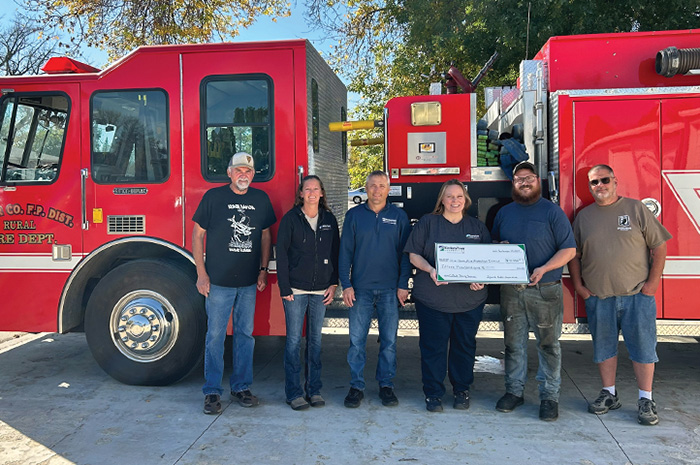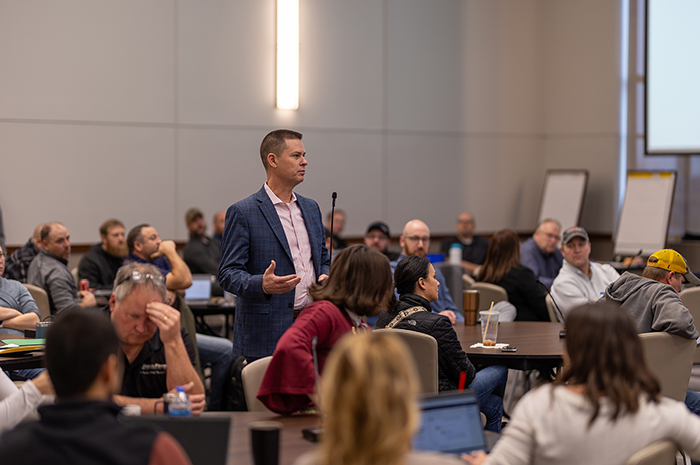Raise the roost
Minnkota, landowners and the Minnesota DNR have worked together to provide a safe, alternative home for ospreys.
When Pam and Kevin Greenwaldt chose a spot for their new home five years ago, they picked a breathtaking one – just a few miles north of Bemidji, nestled next to a charming little lake and a smattering of neighboring homes.
One of those homes stood out from the others, out in the middle of the lake, high above the water, constructed from sticks and grasses. The transmission power line tenants became a part of the Greenwaldt family.
“They’re our birds,” Pam said of the nest-dwelling ospreys currently taking their migratory vacation farther south. “When we first moved here and started building, a woman down the street told us they would never come back, the ospreys. But they did!”
Like a mother hen herself, Pam started to worry about the safety of the birds. “Whenever I see the birds land in there, I say to myself, ‘Please don’t hit, please don’t hit!’ Because the nest was getting so big.”
Minnkota anticipated additional problems with the birds’ precarious roost and decided to work with the Greenwaldts to provide a new nesting platform that would both keep the birds safe and prevent any power issues the massive nest could cause.

On Jan. 3, the Minnkota crew installed a 50-foot pole with a 4-foot square aluminum platform in the Greenwaldts’ backyard, right along the lake’s edge and just 200 feet from the nest’s initial location. The original nest will be removed from the power line.
“We’ll take some sticks off of the nest and put them on that platform to try and entice the osprey to nest there this spring,” said Minnkota area line worker Vern Peterson, who has been working on a relocation plan with Pam and Kevin since the summer. “We’ve done that in the past, and that’s worked. We want to get them to keep nesting here – just not on our power lines.”

A Minnesota home
A project like this is unique to certain areas of the country – ospreys are particular about where they raise their families. In Minnkota’s service area, they are mostly found in central and northeast Minnesota, where they have access to a bounty of lakes and rivers in which to grab fish just under the surface. Unfortunately, their fondness for high perches around water makes power lines perfect osprey real estate.
Minnesota Department of Natural Resources’ (DNR) Christine Herwig explained that ospreys are federally protected as migratory birds and that the DNR requires power companies to obtain a permit and only move or remove a nest between October and April, when the birds fly south.
“Lakes and rivers freeze up and they don’t have access to fish anymore,” Herwig said. “We don’t want to disturb nesting birds. We don’t want to keep them from successfully hatching and fledging chicks.”
Installing a platform during the cold winter months presents some challenges but ultimately works in the crew’s favor. The frosty, snow-covered ground can make digging the 8-foot hole for the platform harder, but a frozen lake allows crews to easily access the power line structure to remove the old nest, either by climbing the pole or, if the ice is thick enough, by truck.
Simply raising the nesting platform isn’t enough. The team also wraps the platform pole with a slippery black material to protect it from woodpeckers, squirrels and other nuisances. To keep ospreys from trying to nest on the line’s crossarm again, they install a plastic, cone-shaped deterrent on which the birds are unable to build.
If this nest were to remain on the line and grow, or another was built in its place, it could eventually trip the line or start a fire. However, this project is about more than power.
“It’s not necessarily always destructive on our end. This is more to protect the osprey and to make sure they don’t get zapped,” said Butch Tester, Minnkota transmission crew foreman.
“It’s a win-win situation,” Herwig added. “If you can put up an alternate platform, that’s good for the birds – they have a place to go – and it’s good for the power company, because the structure that they’re trying to protect can be safe and provide reliable energy.”

This isn’t the first time Minnkota has raised an osprey platform in the area. By working closely with DNR experts, these platforms have supported many successful relocations. In a 2014 case, a Bemidji High School class was pulled into the process as an educational experience.
Back in the Greenwaldts’ lakeside yard, Tester’s team had the pole wrapped, placed and fortified in no time at all, as an eager Pam watched from the sideline and envisioned her adopted osprey family even closer to home.
“I just hope they will take to it,” she smiled.
...



